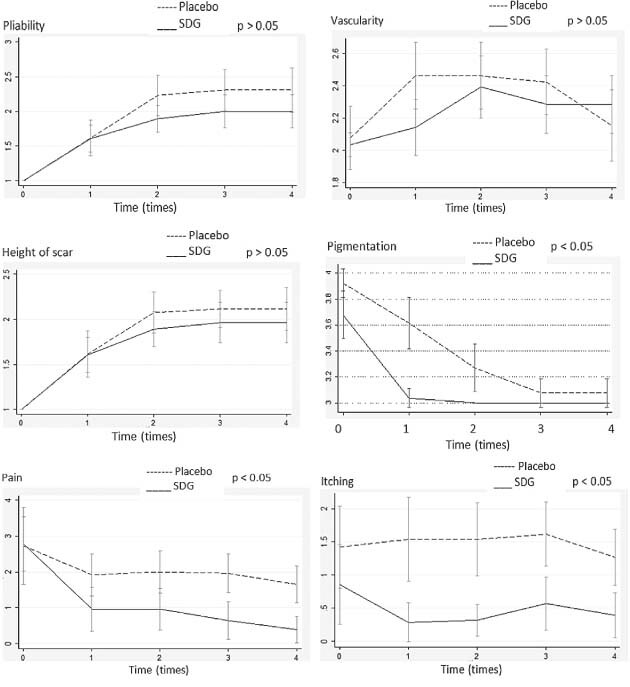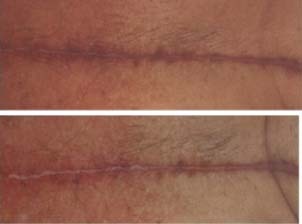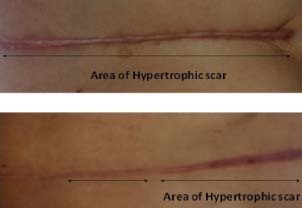Abstract
Use of silicone derivative and onion extract had been reported in the prevention of hypertrophic scarring. Our experience showed the preventive use of silicone derivative plus onion extract gel on hypertrophic scars after median sternotomy. In a randomized, double blinded, placebo‐controlled study, 60 patients after median sternotomy incisions were separated into two groups. All patients were treated either with silicone derivative plus onion extract gel (Cybele® scagel) or placebo gel twice daily for a total treatment period of 12 weeks. During each visit, pain and itching scores were graded by the patients and scar characteristics were observed by surgeons using the Vancouver scar scale. Pain and itch score values from patients' who applied silicone derivative plus onion extract gel was less than another group (P < 0·05). Pigmentation was significantly different between two groups (P < 0·05) and the reduction of scores on vascularity, pliability, height in treated group was not superior to the untreated group. No adverse events were reported by any of the patients. A silicone derivative plus onion extract gel is safe and effective for the preventing the hypertrophic scarring after median sternotomy.
Keywords: Hypertrophic scar, Median sternotomy, Onion extract, Silicone derivative
INTRODUCTION
Hypertrophic scar treatment remains a challenging problem for clinicians. One epidemiological study showed that 30–50% of patients from Asian ethnicity who undergo median sternotomy developed hypertrophic scars, whereas the frequency of occurrence in Caucasian patients is only 10–20% (1). When scars are formed, physical conditions and emotions are affected. They may also cause significant functional and cosmetic impairment (2). Patients may suffer loss in mobility and their ability to perform job functions because of morbidity. Hypertrophic scars tend to cause itch and pain symptoms, which are responsible for a reduction in quality of life (3). Cost of treatment for these scars may also be expensive depending on individual factors such as genetic, type of wound and infection. The normal duration for treatment of scars is approximately 6 months and it may extend to 1–2 years so scar prevention therapy is an interesting alternative in the management of scars.
Although the mechanism of silicone in the improvement of hypertrophic scar still is unclear, it is recommended in the treatment hypertrophic scarring (4). Mustoe's (5) study reviewed several of the products available and the clinical evidence of their efficacy in preventing excessive scarring and improving scars formation. Results from clinical trials suggest that the efficacy of silicone gel is equivalent to that of traditional silicone gel sheeting but is easier to use. Quercetin from onion extract is found in various scar treatment products. It has anti‐inflammatory, bacteriostatic and collagen down‐regulatory properties (6). Topical agents, with a composition of silicone derivative plus onion extract in semi‐liquid gel form, may improve hypertrophic scarring. In this article, we present our experience in the preventive use of silicone derivative plus onion extract gel for hypertrophic scars after median sternotomy.
PATIENTS AND METHODS
From August 2009 to April 2011, patients of age over 18 years, who underwent median sternotomy, were enrolled in the study. All the wounds were subcuticular stitched with Dexon 4‐0. The patients did not receive other treatments before participating in the study. Patients with underlying factors that may influence wound healing process such as usage of steroids, immunosuppressant or patients who did not comply with the study protocol such as those who did not attend follow‐up visits were excluded from the study. Consent forms, which conformed to the ethical guidelines of the 1975 Declaration of Helsinki, were accepted and signed by each patient.
The silicone derivative plus onion extract gel (Cybele® Scagel, Bangkok Botanica, Bangkok, Thailand) in semi‐liquid gel form is formulated from medical‐grade silicone derivative and onion extract as main ingredients. The placebo gel is a composite of water, acrylate, C10‐30 alkyl acrylate crosspolymer, polysorbate20 and fragrance that was similar in colour and consistency as that of active gel. In both groups, application was carried out twice daily, once in the morning and once in the evening. Topical application was initiated at day 7 after surgery. Approximately 3 g of the topical agents were used each time and was enough for covering the wound. Patients applied the gel on the wounds and gently rubbed in until the gel is absorbed. Massaging the wound during the day after the gel application is not required.
Patients were assigned at random to two groups, each group comprising of 30 patients. Either silicone derivative plus onion extract gel (Cybele® Scagel) or placebo gel was applied for total treatment period of 12 weeks. The gels (both Cybele® Scagel and placebo gel) had similar appearance and were packed into similar looking containers. Scar assessments were performed at the beginning and 2, 4, 8, 12 weeks after treatment by three experienced burns doctors. The results evaluation by these doctors was blinded as well.
At each visit, the scars were photographed and evaluated using the Vancouver scar scale to determining scar pigmentation, vascularity, pliability and height (Table 1) (7). Pruritus and pain scores were graded by patients. The maximum score of 10 indicates that the patient has severe symptoms while the minimum of 0 implies that she has no symptom. This evaluation was carried out after topical application for 30 minutes.
Table 1.
Vancouver scar scale
| Assessment | Score | |||||
|---|---|---|---|---|---|---|
| 0 | 1 | 2 | 3 | 4 | 5 | |
| Vascularity | Normal | Pink | Red | Purple | – | – |
| Pigmentation | Normal | Hypopigmentation | Mixed | Hyperpigmentation | – | – |
| Pliability | Normal | Supple | Yielding | Firm | Ropes | Contracture |
| Height | Flat | <2 mm | 2–5 mm | >5 mm | – | – |
Demographic data was analysed by using two‐tailed unpaired student t‐test and chi‐square test. Categorical data was reported in frequency and percentage while continuous data was presented in mean and standard deviation. Repeated measures analysis of variance was used to compare the scores between the study and control group during each visit. Classification of scar characteristics was analysed by Fisher's exact test. Probability levels of less than 0·05 were considered significant. All statistical data analysis was performed with STATA 10.
RESULTS
Fifty‐four patients completed this study; 30 were male and 24 were female. Six patients were excluded because of discontinued follow‐ups [four because of distance (two from study group and two from control group) and two because of heart failure in control group]. There were no significant differences in baseline characteristics. The results of demographic data are shown in Table 2.
Table 2.
Demographic data
| SDG | Placebo | P value | |
|---|---|---|---|
| Gender: male | 17 (60·7%) | 13 (50%) | 0·429 |
| Age | 51·39 ± 12·50 | 48·46 ± 14·47 | 0·428 |
SDG, silicone derivative plus onion extract gel.
At the first visit (start of study, after surgical procedure approximately 1 week), there were no differences in all scar scores between two groups. During the follow‐up (2, 4, 8 and 12 weeks after starting treatment), pain and itch score were significantly lower in the silicone derivative plus onion extract gel group when compared with the control group (Figure 1). In the repeated measure analyses, all parameters of Vancouver scar score assessment improved in the treatment group especially pigmentation. Hyperpigmentation faded significantly at all the time point (P < 0·05). No side effects of the silicone derivative plus onion extract gel were noted in any case. The topical agent was convenient to use and it could be removed easily.
Figure 1.

Patient assessment score and Vancouver scar score in the control and treatment group.
DISCUSSION
Our results show the role of silicone derivative plus onion extract gel in preventing hypertrophic scar after median sternotomy excision. Pigmentation was improved in the treated group, while there were no significant differences between the study and control group for pliability, height and vascularity. Patients who applied silicone derivative plus onion extract gel experienced less pain and pruritus than those using placebo gels.
After skin injuries, the healing process, which can be categorized into the inflammatory phase, the proliferative phase and the maturation phase, is initiated in order to close the wound by epithelization. In the normal maturation phase, the swelling and redness of the wound will soften and flatten out because of collagen synthesis and degradation and the connective tissue elements will degenerate in 6 months to 1 year after injury but this process collapses in hypertrophic scar. Patient with abnormal wound healing would have experience pain, itch on affected area. Hyperpigmentation, scar contractures, hypertrophy can occur and may affected patient's morbidity. Even at the present day, hypertrophic scar is difficult to treat and it can recur even after excision; so prevention is recommended in scar management. This includes the use of pressure garments, microporous adhesive tape support, silicone gel and massages.
There are hypothesis on the various mechanisms of action on hypertrophic scars by topical silicone materials. Silicones are believed to decrease scar via wound hydration 8, 9, 10, 11, 12, increased static charge 13, 14, and higher than normal body temperature. Mustoe (5) described that dehydration of the stratum corneum is signalled to keratinocytes perhaps via an osmotic gradient to produce cytokines, which in epidermal–dermal signalling activate dermal fibroblasts to synthesize and release collagen. Excessive collagen production leads to abnormal scarring. Topical silicone derivative plus onion extract gel might restore the barrier function of the stratum corneum, reducing transepidermal water loss and turning off the stimulation of keratinocytes to produce cytokines that activate dermal fibroblasts.
One previous study reported that the increase temperature at the scar area enhance the scar healing process (15). Silicone gel sheeting has good evidence of efficacy, and it has now become part of the standard care practiced by plastic surgeons 4, 16, 17, 18. However, there are several products containing silicone derivative in semi‐liquid gel form that has equivalent efficacy to traditional silicone gel sheeting 19, 20. In addition, silicone derivative in this form is easy to use and there are fewer side effects compared to conventional silicone gel sheeting 21, 22. Combination of silicone derivative with other active compounds such as onion extract may also have synergistic effects in scar improvement 23, 24, 25, 26, 27. Quercetin, a bioflavonoid from Allium cepa also exhibited antihistamine release effects. It may reduce itching from the scar. Hosnuter et al. (23) reported that the onion extract was more effective in relation to fade scar colour and the most effective therapeutic results were obtained when the silicone gel sheet treatment was combined with onion extract.
At the Srinagarind Hospital, Khon Kaen University, high incidences of hypertrophic scar from median sternotomy wounds are reported especially the thoraco‐abdominal skin junction. Silicone derivative plus onion extract gel application can significantly reduce pain, itch and pigmentation symptoms in treatment groups when compared with control groups according to previous studies 19, 28. There is no significant difference between the study and control group on pliability, height and vascularity. It may be because of the subjective method used in this study. Although the application of this method is easy, it has some unclear definition of variables. We cannot have a definite conclusion on the colour change although visually, the scar was observed to have faded. Besides, the calibration of the scale is not standardised so the grading of the scores may not be precise (Figure 2). In the evaluation of height of the scar, we cannot just evaluate the height of the scar as the lesion may vary in volume (Figure 3). This limitation is usually found in subjective assessment. Objective evaluation may be useful in future studies.
Figure 2.

Different of pigmentation but the same score in the same patient in 2 months after apply silicone derivative plus onion extract gel group; silicone derivative plus onion extract gel (SDG) (upper) and 3 months after apply SDG (lower).
Figure 3.

Different of volume of scar but the same score in height in worst result of both group control group (upper) and silicone derivative plus onion extract gel group (lower).
Another limitation in this study is distance. Almost all our patients live in the rural area and it was inconvenient for follow‐up visits at our unit so this study was conducted over a period of 12 weeks. The duration of therapy should be extended in future studies in order to have a more complete assessment on scar progression.
CONCLUSION
Silicone derivative plus onion extract gel has plausible efficacy in the prevention and treatment of scar formation. It could improve subjective symptomatic pain, itching symptoms and hyperpigmentation of scar.
REFERENCES
- 1. Sproat JE, Dalacin A, Weitauer N. Hypertrophic sternal scars: silicone gel sheet versus Kanalog injection treatment. Plast Reconstr Surg 1992; 90:988. [PubMed] [Google Scholar]
- 2. Li‐Tsang CW, Lau JC, Chan CC. Prevalence of hypertrophic scar formation and its characteristics among the Chinese population. Burns 2005;31:610–6. [DOI] [PubMed] [Google Scholar]
- 3. Bock O, Schmid‐Ott G, Malewski P, Mrowietz U. Quality of life of patients with keloid and hypertrophic scarring. Arch Dermatol Res 2006;297: 433–8. [DOI] [PubMed] [Google Scholar]
- 4. Stavrou D, Weissman O, Winkler E, Yankelson L, Millet E, Mushin OP, Liran A, Halk J. Silicone based scar therapy: a review of the literature. Aesth Plast Surg 2010;34:646–51. [DOI] [PubMed] [Google Scholar]
- 5. Mustoe TA. Evolution of silicone therapy and mechanism of action in scar management. Aesth Plast Surg 2008;32:82–92. [DOI] [PubMed] [Google Scholar]
- 6. Augusti K. Therapeutic values of onion (Allium cepa L.) and garlic (Allium sativum L.). Indian J Exp Biol 1996;34:634–40. [PubMed] [Google Scholar]
- 7. Nedelec B, Shankowsky HA, Tredget EE. Rating the resolving hypertrophic scar: comparison of Vancouver scar scale and scar volume. J Burn Care Rehabil 2000;21:205. [DOI] [PubMed] [Google Scholar]
- 8. Gilman TH. Silicone sheet for treatment and prevention of hypertrophic scar: a new proposal for the mechanism of efficacy. Wound Repair Regen 2003;11:235–6. [DOI] [PubMed] [Google Scholar]
- 9. Atiyeh BS, Ioannovich J, Al‐Amm CA, El‐Musa KA, Dham R. Improving scar quality: a prospective clinical study. Aesth Plast Surg 2002;26:470. [DOI] [PubMed] [Google Scholar]
- 10. Sawada Y, Sone K. Treatment of scars and keloids with a cream containing silicone oil. Br J Plast Surg 1990;43:683–8. [DOI] [PubMed] [Google Scholar]
- 11. Sawada Y, Sone K. Hydration and occlusion treatment for hypertrophic scars and keloids. Br J Plast Surg 1992;45:599–603. [DOI] [PubMed] [Google Scholar]
- 12. Gault DT. Scars and contractures. Surgery 1999;4: 73–5. [Google Scholar]
- 13. Berman B, Flores F. Comparison of a silicone gel‐filled cushion and silicone gel sheeting for the treatment of hypertrophic or keloid scars. Dermatol Surg 1999;25:484–6. [DOI] [PubMed] [Google Scholar]
- 14. Hirshowith B, Lindenbaum E, Har‐Shai Y, Feitelberg L, Tendler M, Katz D. Static‐electric field induction by a silicone cushion for the treatment of hypertrophic and keloid scars. Plast Reconstr Surg 1998;101:1173–83. [DOI] [PubMed] [Google Scholar]
- 15. Musgrave MA, Umraw N, Fish JS, Gomez M, Cartotto RC. The effect of silicone gel sheets on perfusion of hypertrophic burn scars. J Burn Care Rehab 2002;23:208–14. [DOI] [PubMed] [Google Scholar]
- 16. Li‐Tsang CW, Lau JC, Choi J, Chan CC, Jianan L. A prospective randomized clinical trial to investigate the effect of silicone gel sheeting (Cica‐Care) on post‐traumatic hypertrophic scar among the Chinese population. Burns 2006;32:678–83. [DOI] [PubMed] [Google Scholar]
- 17. Niessen FB, Spauwen PH, Robinson PH, Fidler V, Kon M. The use of silicone occlusive sheeting (Sil‐K) and silicone occlusive gel (Epiderm) in the prevention of hypertrophic scar formation. Plast Reconstr Surg 1998;102:1962–72. [DOI] [PubMed] [Google Scholar]
- 18. Momeni M, Hafezi F, Rahbar H, Karimi H. Effects of silicone gel on burn scars. Burns 2008;35:70–4. [DOI] [PubMed] [Google Scholar]
- 19. Chan KY, Lau CL, Adeeb SM, Somasundaram S, Nasir‐Zahari M. A randomized, placebo‐ controlled, double‐blind, prospective clinical trial of silicone gel in prevention of hypertrophic scar development in median sternotomy wound. Plast Reconstr Surg 2005;115:1013–20. [DOI] [PubMed] [Google Scholar]
- 20. Lacarrubba F, Patania L, Perrotta R, Stracuzzi G, Nasca MR, Micali G. An open‐label pilot study to evaluate the efficacy and tolerability of a silicone gel in the treatment of hypertrophic scars using clinical and ultrasound assessments. J Dermatolog Treat 2008;19:50–3. [DOI] [PubMed] [Google Scholar]
- 21. Nikkonen MM, Pitkanen JM, Al‐Qattan MM. Problems associated with the use of silicone gel sheeting for hypertrophic scars in the hot climate of Saudi Arabia. Burns 2001;27:498–501. [DOI] [PubMed] [Google Scholar]
- 22. Gibbons M, Zuker R, Brown M, Candlish S, Snider L, Zimmer P. Experience with silastic gel sheeting in pediatric scarring. J Burn Care Rehabil 1994;15:69–73. [DOI] [PubMed] [Google Scholar]
- 23. Hosnuter M, Payasli C, Isikdemir A, Tekerekoglu B. The effects of onion extract on hypertrophic and keloid scars. J Wound Care 2007;16:251–4. [DOI] [PubMed] [Google Scholar]
- 24. Maragakis M, Willital GH, Michel G, Gortelme‐ yer R. Possibilities of scar treatment after thoracic surgery. Drugs Exp Clin Res 1995;21:199–206. [PubMed] [Google Scholar]
- 25. Willital GH, Heine H. Efficacy of Contractubex gel in the treatment of fresh scars after thoracic surgery in children and adolescents. Int J Clin Pharmacol Res 1994;14:193–202. [PubMed] [Google Scholar]
- 26. Draelos ZD. The ability of onion extract gel to improve the cosmetic appearance of postsurgical scars. J Cosmet Dermatol 2008;7:101–4. [DOI] [PubMed] [Google Scholar]
- 27. Ho WS, Ying SY, Chan PC, Chan HH. Use of onion extract, heparin, allantoin gel in prevention of scarring in chinese patients having laser removal of tattoos: a prospective randomized controlled trial. Dermatol Surg 2006;32:891–6. [DOI] [PubMed] [Google Scholar]
- 28. Li‐Tsang CWP, Zheng YP, Lau J. A randomized clinical trial to study the effect of silicone gel dressing and pressure therapy on posttraumatic hypertrophic scars. J Burn Care Res 2010;31: 448–57. [DOI] [PubMed] [Google Scholar]


